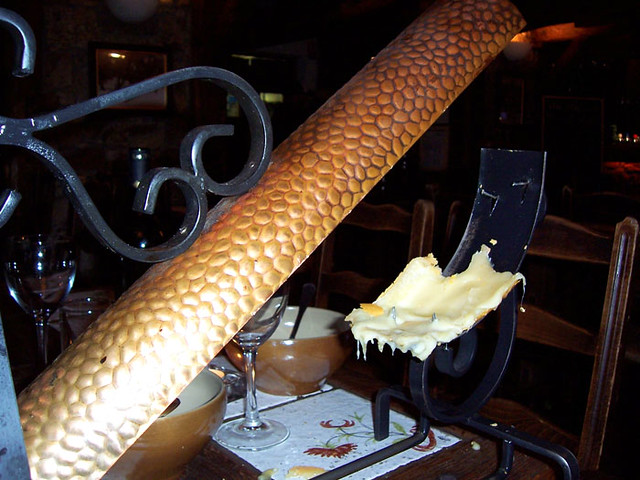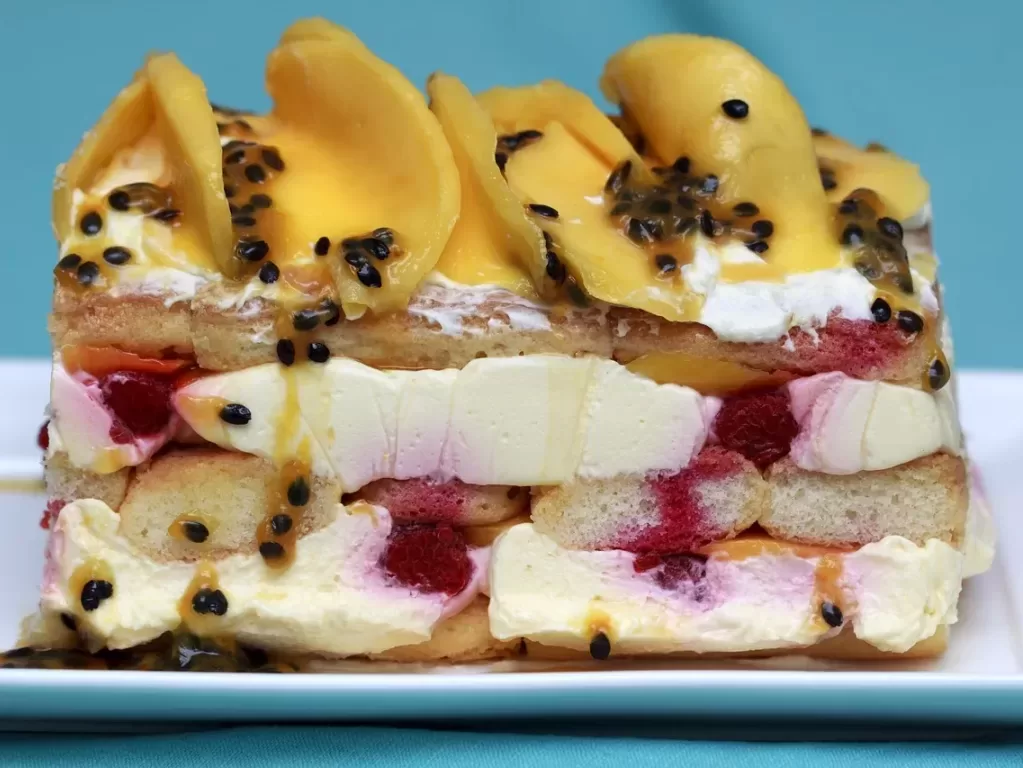Raclette: The other fondue
The mention of melted cheese probably conjures up images of fondue pots and ‘70s dinner parties for many. However, fondue is just one of many melted cheese dishes in France. Raclette is one of the alternatives, and it’s just as much fun to prepare and eat, but without the worry of the cheese clumping into a glob before making it to the table. That’ll happen in your belly later on.
Raclette is both a dish and a type of cheese served in Switzerland and France. Made in round five or six kilogram blocks and with a salty crust, the cheese is normally served in restaurants sliced down the middle to form a half-moon shape, then placed on a metal holder with a heater to melt the top layer of cheese. Once melted, the layer is scraped off and eaten with potatoes, cold meats and gherkins. Some people prefer to leave the crust (including American chef, Rob, pictured), but it’s edible and very tasty.
At-home raclette grills are different, with mini frying pans for melting pre-sliced cheese. This means you can get creative! Raclette is available infused with other tastes, such as white wine, mustard seeds or herbs, or try the smoked variety, called brezain. Add a slice of goats cheese for extra zing, or skip the raclette cheese altogether and go for the ash-laden morbier or any of your favourite melt-friendly cheeses. The whole raclette dinner experience is sociable, fun and tasty.
Raclette is said to have originated from Valais in Switzerland, documented back to medieval times, when locals would sit the cheese by a campfire, then scrape the melted layer onto rye bread to eat. In 2003, Raclette du Valais was given AOC status (Appellation d’Origine Contrôlée), although other regional raclettes, such as Raclette de Savoie (France), Raclette des Appalaches (Canada) and Heidi Farm Raclette (Australia), also exist.
Many farms and co-operatives in the French Alps have viewing areas for the public to watch the cheese-making process. Here, you will see that raclette starts off as a square of cheese, with a red or green label placed on it. Farm-made cheese has a green label, while cheese made from several sources of milk, such as that made in a co-operative, has a red label.
Each square is put into a round mould, then pressed from above to remove excess liquid. The process makes the cheese round and flatter, and it is left to ripen for four or five months, with the rind brined regularly.
The local French have several raclette traditions. The most important is to drink local white wine with the cheese. They say the wine helps to break up the glob of cheese building in their stomachs. Whatever you do, don’t order red wine. This is a local dish served with local wines only, and the Rhône-Alpes region isn’t famous for red wine. Locals will also warn you off drinking water with raclette: it will only cause the ball of cheese in your belly to firm up, as will any other non-alcoholic beverages. When everyone is too full to eat any more, locals will insist that a shot of locally-made genepi will help the digestive process.
Raclette first-timers might think the scraping process is easy, but there are a few things that the nominated scraper should know. First up, if the crust is not scraped off with each layer of cheese, it becomes impossible for the cheese to melt evenly, and the hardening crust must be sliced off. Secondly, the flat part of the cheese can sometimes become angled, causing the cheese to fall off to one side during each scrape. To look like a pro, keep your cheese flat and crust-free. Finally, be careful not to let the cheese touch the electric grill. Apart from it smelling bad and causing smoke, baked-on cheese is a nightmare to clean.
Remember, raclette requires time. The first few rounds of scraping are so slow that the meal seems unlikely to ever end! But this cheese won’t take long to fill even the most hollow-legged person. Once through those first few impatient rounds, let the cheese bubble a bit longer until it turns brown and increases in flavour. If nothing else, it’ll give your stomach a chance to reduce that cheese ball before you add a bit more to it.
TOP TIP: If you’re hungry for a snack, try slices of raclette cheese grilled on toast. Delicious!
Image credits:1. A typical raclette grill, with US chef, Rob, scraping the cheese for his plate and leaving the edible rind for the bin.
2. Raclette cheese square with red co-op label. The man in the background is placing it in the round mould where it will be pressed to form a flat circle.
3. With enough people, the entire half of cheese CAN be eaten — crust and all.










I learned tons reading this! Thanks, Wendy!
I’m glad you enjoyed it, Elisabeth. I’m sure you’d enjoy the cheese even more. 🙂
Wow, Wendy, I love raclette, but had no idea about all the details. Thanks! A few of my French friends here in Melbourne have raclette grills, and I eagerly await dinner invitations. 🙂
I loooove raclette! You make it sound much more complicated than I considered it though. I’m pretty much used to the simple raclette with pre-cut slices of cheese that you let melt in the “appareil à raclette”. This is really simple to use and wash. I’ve never had a real raclette yet I guess. In any case, people should try raclette in Germany. They’re pretty good with it as well! 🙂
Ron, I’m interested to know how the raclette compares in Australia – whether it’s imported or made there (I know there are a few French cheesemakers who have started up Down Under recently).
Julie, Oh no – I didn’t want to make it sound complicated! Basic raclette is great, but there’s a whole world of options that exist out there (German raclette, for example), so it’s worth a bit of exploration, I feel. Regardless, it’s all just cheese to melt under a grill and a bit of crust maintenance so nothing too complicated hopefully.
Oh I see 🙂 I think what I’ve tried is something like the “modern” raclette. I’d like to try an old-world raclette like the one you described. Actually, what I’d like even more is to try a cheese fondue like the fondue savoyarde. Because as famous as it may be, I’ve never got an occasion to taste it. The only fondue I’ve tried is the fondue bourguignonne, where you dip small pieces of beef into boiling oil. It is very good when well seasoned. And it’s not as fat as one may think.
I was puzzled about why it’s called a fondue, though, since the meat doesn’t really “melt”. I looked it up. Apparently, the principle of any fondue is to dip small pieces of a food item into something liquid (it still doesn’t make sense for meat, does it).
Oh and I almost forgot “la fondue au chocolat” !! Is it famous outside of France ? I’d say it’s the most popular of all fondues in France, especially among teenagers and young adults I think. I like to have one with bananas, strawberries, marshmallows and some “madelaines”. It goes without saying that the chocolate should be good quality (dark) chocolate 🙂
Actually Wendy, I don’t think it’s raclette cheese, probably gruyere or emmental or some other melty cheese. After a few wines, I don’t really care. Melted cheese with potato, ham, onion, just feed me! Miam, miam!
Julie, chocolate fondue is something I’ve experienced many times in Australia, England and France. My favourite fruits are kiwi, pineapple and banana. The tang of the first two fruits is glorious, and banana and chocolate is just unbeatable for me. Fondue Savoyarde is lovely – if you can try one with morilles (a local mushroom), it creates a slightly richer flavour.
Ron, that’s the attitude. I think I ate five types of cheese yesterday and I still wasn’t cheesed out (including a fondue). All cheese is good cheese (except that extremely smelly one or the Italian one that has liquified after the mites have done their thing to it – eww).
Thank you for the good advice Wendy 🙂